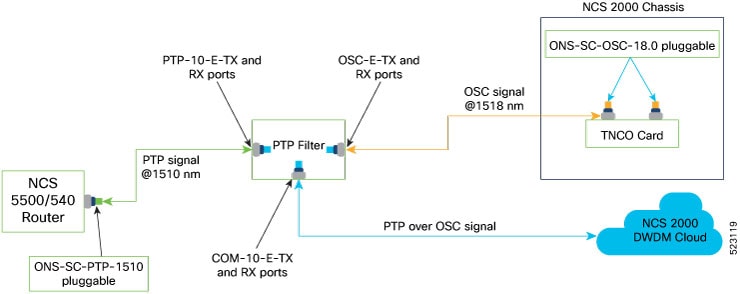Overview of PTP
Challenges
In today's fast growing network traffic, network operators are adding new nodes to ensure smooth traffic flow in data centers and networks. Addition of new nodes increases the latency of data over the networks. Network latency poses huge challenge for network operators. To avoid delays in synchronizing time signals and latency in the network, the need for precise timing synchronization is on the rise. PTP offers synchronizing timing solution across networks with high precision.
Solution
Cisco has devised the PTP solution over NCS 2000 networks to help you avoid latency and ensure timing synchronization in your networks. NCS 2000 provides the operational capacity to meet your ever-increasing network needs. PTP for the NCS 2000 networks combines the operational functionality of NCS 2000 and precise PTP synchronization to enhance the efficiency of your networks. You can implement this solution over an existing NCS 2000 optical network using NCS 5500 and NCS 540.
The NCS 5500 and NCS 540 routers provide PTP support to the NCS 2000 networks. The solution leverages the PTP signal from NCS 5500 and NCS 540 to provide a path for transparent clock synchronization over the NCS 2000 network.
Previously, the NCS 2000 networks used an in-band channel to send PTP signal from NCS 5500 and NCS 540 through the network to synchronize timing reference. PTP signal that is sent over an in-band channel limited users from utilizing the entire NCS 2000 bandwidth. The PTP filter is introduced to propagate the PTP signal through an out-of-band OSC signal at 1518 nm. Keeping all in-band channels available for carrying traffic, this filter enables you to utilize all the channels in the NCS 2000 networks.
In the following example, the Grandmaster (GM) clock feeds the PTP signals to the NCS 5500 router (First Router) through a primary clock (TBC). The ONS-SC-PTP-1510 pluggable that is installed in the NCS 55xx router enables the router to synchronize timing signals over the NCS 2000 DWDM cloud.

On the NCS 55xx router side, the PTP (optical clock) signal is generated using an external clock that acts as the GM clock. The GM clock synchronizes the PTP signal with Boundary Clocks (BC), both primary and secondary clocks, which are distributed over the network. Primary clocks initiate their own PTP session with downstream secondary clocks to mitigate the number of network hops and packet delays between the GM and secondary clocks. The ONS-SC-PTP-1510 and ONS-SC-PTP-1514 pluggable optics are introduced to support the NCS 55xx routers to propagate the PTP clock signals over the NCS 2000 DWDM cloud.
The PTP solution is implemented using SFP pluggable optics and a PTP filter. The PTP filter combines and splits the PTP and OSC signals in the NCS 2000 network. The pluggable optics are inserted in the NCS 5500 and NCS 540 routers to send the PTP signal. This solution requires the following pluggable optics and filter:
|
Product ID |
Description |
|---|---|
|
ONS-SC-PTP-1510 |
Multirate GE, FE pluggable optics, 1510 nm, C-temp |
|
ONS-SC-PTP-1514 |
Multirate GE, FE pluggable optics, 1514 nm, C-temp |
|
15216-OSC-PTP |
Passive OSC-PTP coupler filter, 1510 nm, 1514 nm, 1518 nm |


 Feedback
Feedback